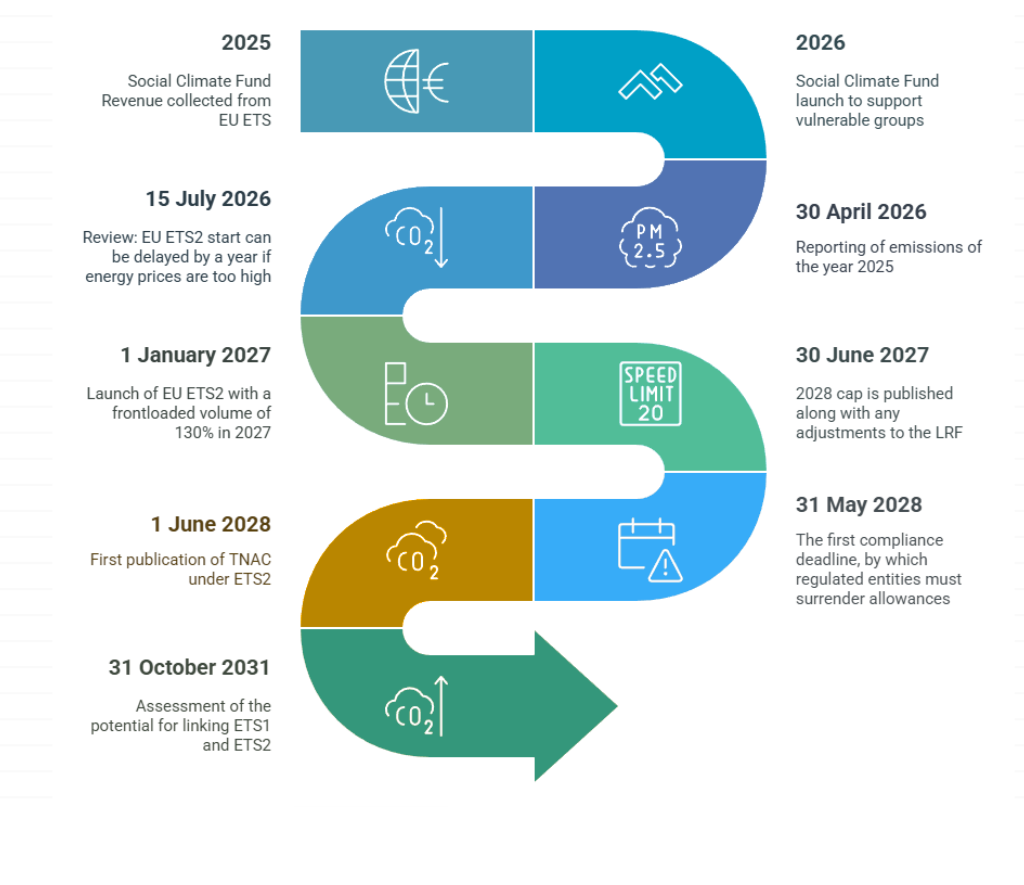EU ETS 2 risks disproportionately impacting vulnerable communities and social service providers
Eurodiaconia acknowledges the critical need for a just environmental transition that combats climate change while safeguarding vulnerable communities. To effectively contribute to this transition, Eurodiaconia supports its members on their role to mitigate climate change and support people affected by the rapidly changing environment.
One of the identified challenges is the introduction of ETS2 and the potential social impact for social service providers and for the vulnerable communities they serve. Therefore, Eurodiaconia commissioned a report to ClearBlueMarkets to have further objective information about the upcoming carbon market.
The report focuses on the specificity of the market, going into dept in its nuances, but also establishes the ETS2 price forecast. Furthermore, the report explores the impact of ETS2 on the road transport and building sector. Finally, it dives into the specific country context (of Croatia, Czech Republic, Estonia, Romania, Poland, Hungary, Lithuania, Sweden, and Luxembourg) to preview the potential social impact for vulnerable groups and social service provision.
This report is an objective source of information, developed by ClearBlueMarkets based on their price forecast and does not represent Eurodiaconia’s view on the topic.
What is ETS2?
The EU Emissions Trading System 2 (EU ETS 2) is a new carbon market created by the European Union to help reduce pollution from sectors that were not previously covered by the original EU ETS. Launched in 2023 as part of the EU’s “Fit for 55” climate plan, ETS 2 focuses on cutting emissions from buildings, road transport, and small industries. Its main goal is to reduce emissions from these sectors by 42% by 2030 compared to 2005 levels.
Under the ETS2, fossil fuel suppliers will purchase allowances from auctions and surrender them at the end of each year, equivalent to the emissions from the fuel they sell. Emissions across these sectors will be capped and required to decrease annually.
Overall, ETS 2 is designed to encourage cleaner choices—like better-insulated homes and low-emission vehicles—while helping the EU meet its climate goals in a fair and balanced way
What does it mean for vulnerable people and social service providers?
While the EU ETS 2 is designed to curb pollution and accelerate the green transition, it also raises significant social concerns—particularly for low-income households. Although the responsibility for purchasing carbon allowances falls on fossil fuel suppliers, these companies are expected to pass the added costs to consumers. As a result, everyday essentials such as heating and fuel are likely to become more expensive.
This burden will likely not be felt equally. Lower-income families, who already spend a larger share of their income on energy, are especially vulnerable. Many rely on older, fossil fuel-based heating systems and vehicles, as the upfront costs of cleaner alternatives like electric cars or heat pumps remain out of reach. Over time, these outdated systems prove more costly and environmentally damaging, yet financial constraints limit the ability to switch.
Social service providers, which play a vital role in supporting vulnerable populations, may also face rising operational costs. Those operating from older, less energy-efficient buildings will be especially affected, potentially straining their ability to deliver essential services.
What does it mean for member-states?
As a European level carbon market, ETS2 is expected to have different effects depending on the context of each member state, according to the income of the country, dependence on fossil fuels, percentage of electric vehicles on the roads, among other factors.
The impact is expected to be more pronounced in lower-income EU countries such as Hungary, Poland, and Lithuania—particularly in rural areas where dependence on private transport and fossil fuels is higher.
This report analyses the expected social impact of the ETS 2 in Croatia, Czech Republic, Estonia, Romania, Poland, Hungary, Lithuania, Sweden, and Luxembourg.
What is the Social Climate Fund?
Recognising that rising fuel and heating costs (due to the ETS2 introduction) could disproportionately affect low-income households and vulnerable communities, the European Commission created the Social Climate Fund.
The Social Climate Fund is dedicated to supporting the most vulnerable groups, namely households, micro-enterprises and transport users specially affected by the introduction of the ETS2. Moreover, the fund should particularly target households that are grappling with energy or transport poverty, ensuring that no one is left behind in the green transition process.
To fulfil this objective, the Fund may be employed to finance structural measures and investments in energy efficiency, renovation of buildings, clean heating and cooling systems, and the integration of renewable energy sources, as well as low-emission mobility solutions. Furthermore, Member States will have the discretion to allocate a portion of the resources to temporary direct income support.
All these measures and investments must be compiled into national Social Climate Plans, developed through public consultations. Member States are mandated to submit these plans to the European Commission by June 2025.
To finance these initiatives and investments aimed at supporting the most vulnerable groups, the Social Climate Fund will consolidate revenues from the auctioning of allowances under the ETS2, along with allowances from the existing EU ETS. However, the SCF provisions establish a maximum of 65 billion Euros and that Member-States will have to support 25% of the cost of their plans.
Key Milestones in the EU ETS2 Implementation




